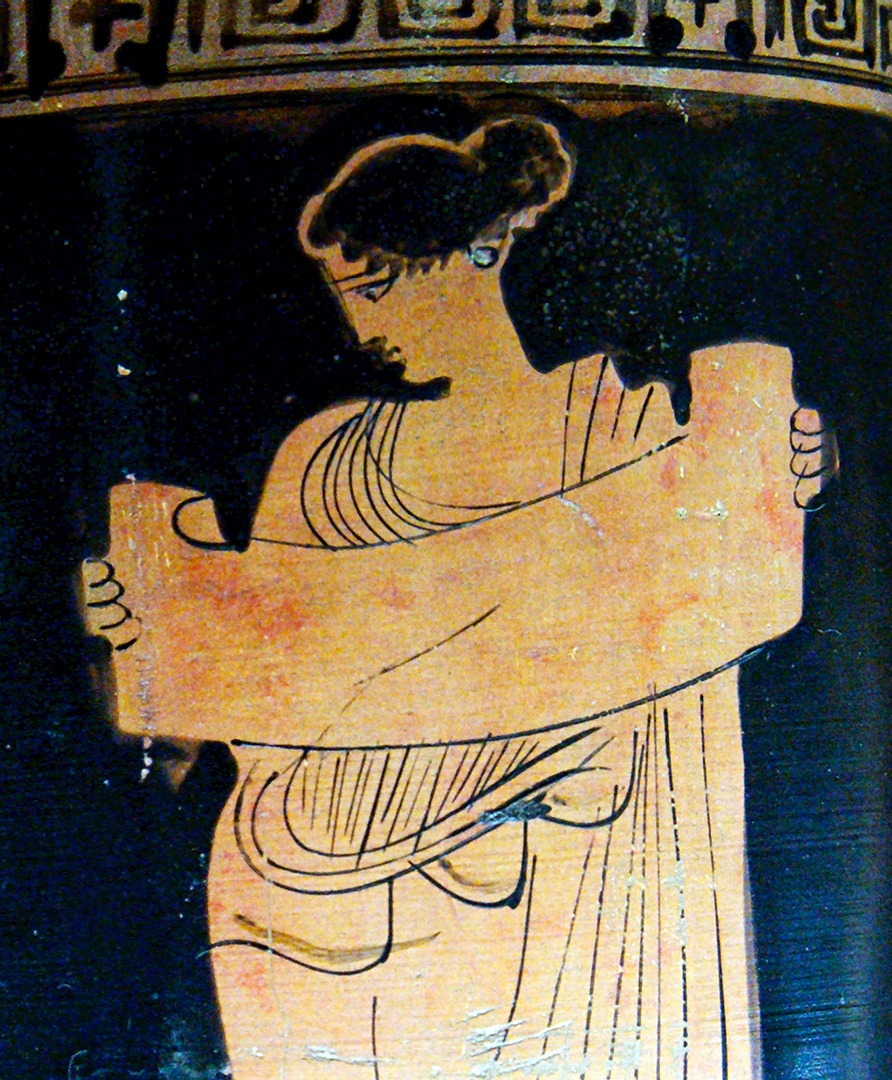Resources
Resources for Teachers:
Bring Any Subject To Life
Visiting schools across the country over the years has given me a tremendous respect for teachers — you are all heroes in my eyes! You manage to do so much with so little, often making huge personal sacrifices in the process. These downloadable resources are designed for use in your libraries and classrooms. Whether you are teaching a sixth-grade social studies/language arts core curriculum unit on Greco-Roman culture or an AP level World Language class, you are sure to find something here to spark your students’ interest and enhance their learning experience.
Muse reading a scroll, circa 435-425 BC
JUMP TO:
- Ancient Voices: Bringing the Greeks to Life for Grades K-12
(this essay gives context to the worksheets provided here and includes complete instructions for making large hand-held replicas of the masks I use in performance.) - Worksheet for Sixth Grade Social Studies/Language Arts
- Worksheets for World Language Arts Classes
- Request a Visit by Kate
Worksheet for Sixth Grade Social Studies & Language Arts
Perfect for interdisciplinary/core curriculum projects, this chart is a starting point for everything from persona poems, dramatic monologues, dialogues and Readers’ Theater scripts. The masks are large enough for students to print out their material and attach to the back — no memorization required! The symbols and emblems included are important design elements that will help the audience identify the characters your students’ masks represent.
Worksheets for World Language Arts Classes
Use these charts as starting points for many projects, including persona poems, dramatic monologues, dialogues and scripted skits. The masks are large enough for students to print out their material and attach to the back—no memorization required! The symbols and emblems included are important design elements that will help the audience identify the characters your students’ masks represent.

Worksheets for Spanish Classes

Worksheets for French Classes
Chart II provides a list of characters from classic French Fairy Tales. Works equally well for younger students, who may enjoy reenacting their favorite stories or making up their own.

Worksheets for Latin Classes
Use this chart of the twelve Olympians to jumpstart a project, but you could also use historical figures from ancient Greece and Rome: Homer, Aristotle, Alexander the Great, Virgil, Ovid, Caligula, Caesar—the list goes on and on. You could also construct an entire list of important female figures: Aspasia of Miletus, Agnodice of Athens, Hypatia of Alexandria, Hipparchia of Marneia, Arete of Cyrene, Telesilla of Argos, to name just a few on the Greek side. Might make a great research project.

Worksheets for Arabic Classes
This chart offers a selection of historical characters from the Islamic Golden Age and introduces students to a fascinating period of cultural, economic and scientific flourishing dated between the 8th and 14th centuries. It represents a starting point, only — any number of charts could be created with specific languages/countries/cultures in mind.

Worksheets for Hebrew Classes
This chart represents selected characters from the Old Testament, including symbols and emblems appropriate to each, but any number of biblical heroes/heroines would work equally as well. A chart of historical figures from ancient times to the 20th century would also be a great way to jumpstart a project.

Worksheets for German Classes
Use this chart to introduce students to the ancient Germanic/Norse pantheon of gods and goddesses and to jumpstart a project.

Worksheets for Chinese Classes
Chart I lists characters from the I Ching, an ancient system of divination that not only provides a perfect window on an ancient culture but also shows the unique perspectives of two of China’s most famous philosophers, Lao Tse and Confucius. Each character represents the member of a family, which makes them instantly relatable to your students. Every student knows what it means to be the oldest brother, the youngest daughter, the middle child. Through the characters of the I Ching, students get a picture of the ancient Chinese family and the significance of birth order, both then and now.
Chart II features characters from Chinese Opera, which offer rich opportunities for making masks. Originally the actors wore masks made of white-painted willow wood, so plain white poster board might be preferable to the metallic-finished board suggested in my mask instructions. You also could create any number of charts featuring gods and goddesses, emperors of historical dynasties or characters from the Chinese Zodiac.










